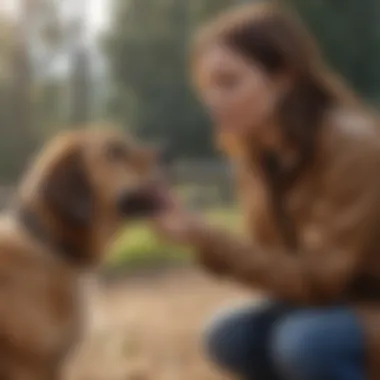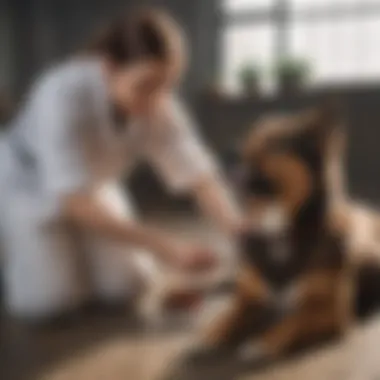Understanding and Responding to Choking in Dogs


Intro
Choking in dogs is a life-threatening situation that requires immediate attention. Understanding how and why it happens is crucial for any pet owner. This condition can escalate rapidly, leading to severe consequences if not addressed promptly. Recognizing the signs of distress, knowing the potential causes, and taking swift action can mean the difference between life and death for your canine companion.
Dogs, by nature, are curious and often will put objects in their mouths. This behavior, while normal, can lead them to ingest something harmful or obstruction their airway. Therefore, having a comprehensive understanding of this issue is essential for safeguarding your pet's health and well-being.
Understanding Your Pet
Breed Traits
Certain dog breeds are more susceptible to choking than others. Breeds with short snouts like Bulldogs and Pugs often have narrow airways, making them prone to airway obstructions. Additionally, breeds with strong prey drives, such as Terriers, might be inclined to chew on and swallow items they shouldn’t. Understanding these breed-specific traits can help pet owners take precautionary measures.
Common Temperaments
A dog's temperament can influence its likelihood of choking. Highly active dogs may be more likely to grab objects and play roughly, increasing the risk of accidental ingestion. In contrast, calmer breeds might be less prone to such behaviors. Pet owners should observe their dog's behavior and take steps to mitigate risks based on their pet’s propensity for impulsive actions.
Special Needs
Some dogs may have special needs, such as those recovering from surgery or those with dental issues. These special circumstances can increase the risk of choking. Pet owners must be vigilant and tailor their care accordingly. Regular veterinary check-ups and discussions about individual health risks are key components in managing special needs.
Pet Care Essentials
Nutrition and Feeding Guidelines
Proper nutrition is vital for preventing choking incidents. Owners should provide suitable food that matches their dog's size and breed. Choose kibble that is appropriately sized and avoid giving bones or hard treats that can splinter. Familiarize yourself with safe feeding practices, such as supervising mealtime to watch for potential issues.
Grooming Tips and Techniques
Regular grooming helps remove loose fur or debris that may pose a choking risk. Brushing your dog frequently keeps their coat healthy and minimizes the chances of hairballs, especially in long-haired breeds. Additionally, regular dental care can prevent food buildup that may lead to choking incidents.
Health and Wellness
Maintaining your dog's overall health is a proactive way to minimize choking hazards. Regular veterinary visits can ensure that your pet's health is monitored and any hidden conditions addressed. Vaccinations, deworming, and dental check-ups play a significant role in a dog's well-being and can impact their likelihood of choking.
Training and Behavior
Basic Training Techniques
Training is essential for ensuring your dog follows commands. Basic commands like “leave it” or “drop it” can be instrumental in preventing choking incidents. Reinforcing positive behavior through consistent training can help your dog make safer choices.
Behavioral Problems and Solutions
Addressing behavioral problems promptly is essential. If a dog exhibits compulsive chewing or ingests items inappropriately, it may signal underlying anxiety or boredom. Consulting a professional dog trainer or behaviorist can help strengthen your pet's behavior and reduce unnecessary risks.
Mental Stimulation Activities
Providing adequate mental stimulation prevents boredom and reduces the chances of your dog engaging in risky behavior, such as chewing inappropriate objects. Utilize toys designed for intelligence stimulation, which can keep your dog engaged and distracted from unsafe items.
Engaging with Your Pet
Interactive Games and Toys
Interactive games are beneficial for mental and physical stimulation. Tug-of-war or fetch using safe toys can enhance the bond with your pet while ensuring they stay occupied. Always monitor playtime to prevent accidents or ingestion of small parts.
Safe Outdoor Activities
Outdoor activities should cater to your dog's safety. Opt for securely fenced areas and monitor your dog closely. Avoid activities near areas where harmful objects could be present, such as construction sites or heavily littered parks.
Family-Friendly Pet Interactions
Encouraging family members to engage in safe activities with the pet is important. Teaching children how to play gently prevents inadvertent accidents. Establish rules on what toys and activities are safe for your pet and ensure the entire family is on board.
Pet Adoption and Integration


Choosing the Right Pet for Your Lifestyle
When considering adopting a dog, reflect on your lifestyle. Some breeds are more prone to health issues than others. Researching breed needs helps in making an informed choice. Ensure that your prospective pet aligns with your family’s dynamic and activity level.
Preparing Your Home for a New Pet
Preparation is essential when bringing a new dog home. Remove hazardous items and small objects that may pose a choking risk. Create a comfortable space for your pet and familiarize them with the layout of your home.
Tips for Smooth Foreword
When integrating a new pet into your household, take time to introduce them gradually to all family members. Monitor interactions and maintain rules to ensure a positive experience for everyone.
Proper understanding of your pet’s needs can greatly enhance their safety and well-being.
With this foundational knowledge, pet owners can better prepare themselves to handle choking incidents in dogs and ensure their beloved pets remain safe and healthy.
Prelims to Canine Choking
Choking in dogs is a serious health concern that requires immediate attention and understanding. Many pet owners may not fully grasp the risks associated with this issue, but awareness can mean the difference between life and death for a dog in distress. In this section, we will explore the definitions and critical nature of choking in dogs, setting the foundation for greater insights into this health crisis.
Defining Choking in Dogs
Choking occurs when an object partially or fully obstructs the airway, making it difficult for a dog to breathe. This obstruction can be a physical object like a toy, food, or any material that becomes lodged in the throat or windpipe. When a dog chokes, the animal may exhibit visible signs of distress, struggling to inhale, cough, or gag. Understanding the anatomy of a dog's respiratory system can help clarify how choking occurs. The trachea leads from the oral cavity to the lungs. If an obstruction occurs here, airflow is restricted, and immediate action becomes essential.
Recognizing the types of materials that commonly cause choking can also aid in prevention. For example, small bones, rubber toys, and even soft food items can sometimes present risks. By understanding choking, pet owners can become more proactive in safeguarding their dogs' health.
Why Understanding Choking is Critical
It is essential for pet owners to grasp the implications of choking, as the timely response during an incident can be crucial. Dogs are naturally curious creatures, often engaging with various objects around them. This curiosity can lead to unintended choking situations, sometimes even during play or feeding. Recognizing the signs of choking early can enhance survival rates and minimize potential harm.
Moreover, knowing how to respond correctly can not only save a pet's life but also reduce panic in the moment. Many dog owners may feel overwhelmed under such pressure. Familiarity with an action plan can provide a sense of control and calm during a potentially traumatic experience.
Common Causes of Choking
Understanding the common causes of choking in dogs serves as a vital foundation for any pet owner. Identifying these causes early can prevent distress and even save a canine's life. Choking often occurs suddenly and without warning, making awareness crucial. Many factors contribute to choking, including the dog's environment, habits, and even congenital conditions. By recognizing these risks, pet owners can take proactive steps to reduce the likelihood of choking incidents.
Types of Food and Objects
Food items play a significant role in choking hazards. Dogs are more likely to choke on certain foods that are difficult to chew or swallow. Common offenders include
- Large pieces of meat or bones: Dogs may tend to gulp large portions without chewing well.
- Hard treats: Items like bully sticks and rawhide can become lodged in a dog's throat.
- Non-food objects: Items such as toys, clothing, or even household items can attract a dog's attention and become choking risks. Ingestion of these objects often leads to serious complications.
It is essential to supervise dogs during mealtime, opting for smaller, easily digestible foods. Additionally, avoid letting dogs roam freely with small objects in their reach.
Playtime Risks and Dangers
Play is crucial in a dog's life, but it can also lead to choking incidents. Toys designed for play should be evaluated for safety. Some toys contain small parts that can be easily chewed off and swallowed. Toys that are too small or excessively hard can create a choking hazard. Even seemingly safe items can become dangerous. For instance, a game of fetch with balls that are too small can lead to unexpected situations.
To mitigate these risks, it’s advisable to
- Choose size-appropriate toys that can't fit entirely in the dog's mouth.
- Regularly inspect toys for wear or damage that could create choking hazards.
- Avoid interactive toys if they are not specifically designed for your dog’s size and chewing style.
Regular monitoring while dogs play can help ensure a safe environment. Teaching dogs to play gently and not to fetch small items can also be a beneficial approach.
Obstructive Pathologies
Some dogs may experience choking due to underlying medical conditions. Obstructive pathologies, including narrow airways or growths in the throat, can lead to choking episodes. Brachycephalic breeds, such as Bulldogs and Pugs, are particularly prone to respiratory problems that can make choking more likely. Understanding these medical issues helps pet owners to recognize symptoms early.
Regular veterinary check-ups become essential for these breeds. They can help identify potential risks related to airways and provide solutions even before choking incidents arise. Awareness regarding any symptoms related to obstructive pathologies can prompt timely interventions.
Recognizing Signs of Choking
Recognizing signs of choking is essential for any dog owner. Timely intervention can mean the difference between life and death for your canine friend. When a dog is choking, it may exhibit various physical and behavioral signs. Understanding these signals enables pet owners to respond swiftly and appropriately, minimizing potential harm.
Physical Indicators of Distress


When a dog is choking, it may show various physical indicators of distress. Some of these signs can be subtle, while others are unmistakable. Common physical signs include:
- Gagging or coughing: Repeated coughing or gagging sounds may happen as the dog tries to clear its throat.
- Pawing at the mouth: The dog may use its paws to try and dislodge the object that is causing the blockage.
- Difficulty breathing: A dog may exhibit labored breathing or may struggle to breathe altogether.
- Blue-tinged tongue or lips: A lack of oxygen can cause a dog's tongue or gums to turn blue.
- Excessive drooling: Increased salivation can occur when a dog is in distress.
These indicators require immediate attention. Owners should remain calm but act quickly if any of these signs appear.
Behavioral Responses to Choking
In addition to physical signs, behavioral responses provide insight into a dog's condition during a choking incident. Dogs manifest their distress in various ways, including:
- Pacing or restlessness: A choking dog may not be able to sit still and might constantly move around.
- Whimpering or whining: Vocalizations that are unusual for the dog can indicate fear or distress.
- Hiding or withdrawing: Some dogs may try to isolate themselves in an effort to cope with the discomfort.
- Increased aggression: Pain and anxiety can cause dogs to react defensively.
Recognizing these behavioral cues is just as critical as observing physical signs. Owners must be vigilant and empathetic during such moments, as understanding their dog's state of mind can guide appropriate action.
Take immediate action if you notice any of these signs. Quick response can save your dog's life.
Together, both physical indicators and behavioral responses form a crucial part of understanding choking in dogs. An awareness of these signs empowers pet owners to act effectively and ensure the safety and well-being of their beloved companions.
Immediate Response to a Choking Incident
When a dog is choking, immediate action can mean the difference between life and death. Understanding how to respond effectively is crucial for every pet owner. This section outlines key aspects of dealing with a choking incident, aiming to equip you with practical knowledge. Quick, informed actions save lives and alleviate the stress of such an emergency.
Assessing the Situation
The first step in responding to a choking dog is to assess the situation. Take a moment to observe the dog’s behavior. Is it coughing, gagging, or showing signs of distress? Look for the universal signs of choking:
- Difficulty breathing
- Pawing at the mouth
- Change in color, especially a bluish tint
- Signs of agitation or panic
Ensure you remain calm to avoid further distress for your pet. If you can, safely approach the dog, keeping in mind its potential anxiety. Understanding what is happening allows you to take appropriate action swiftly.
Techniques for Helping a Choking Dog
Back Blows
Back blows involve delivering firm pats on the dog’s back. This technique helps dislodge objects from the airway. A key characteristic of back blows is their simplicity. They can be performed quickly and are often the first response to a choking incident.
When administering back blows:
- Firmly hold the dog in a standing or slightly forward position.
- Use the heel of your hand to deliver up to five strong blows between the shoulder blades.
One advantage of back blows is they can be effective for certain blockages. However, this technique might not work for every situation, especially in cases of severe obstruction.
Abdominal Thrusts
Abdominal thrusts (also known as the Heimlich maneuver) is another effective method for removing an obstruction. This technique specifically targets the diaphragm, which can force air up and expel the object. A key characteristic of abdominal thrusts is their ability to generate significant force.
To perform abdominal thrusts:
- Stand behind the dog, placing your arms around its waist.
- Make a fist and place it just above the navel. Grasp your fist with your other hand.
- Quick, inward and upward thrusts can help to expel the object.
Though abdominal thrusts can be highly effective, there is a risk of injury if done incorrectly. It is important to be cautious and ensure you are applying enough but not excessive force.
Checking the Mouth
Checking the mouth of a choking dog is also essential. If you can see the obstruction, gently remove it if possible. This technique is vital as it allows you to identify what is blocking the airway.
When checking the mouth:
- Carefully look inside without using your fingers abruptly, as this may push the object further.
- If the object is visible and can be grasped easily, try to remove it gently.
The advantage of checking the mouth is that it can provide immediate assistance. However, if the object is lodged deeply, attempting to retrieve it might cause harm. It's vital to be gentle and not provoke more panic in the dog.
When to Seek Veterinary Assistance
Even after administering immediate responses, consulting a veterinarian is often necessary. If the dog continues to show signs of distress, or you are uncertain if you have effectively cleared the blockage, do not hesitate to seek professional assistance. Time is essential in these situations. Regular check-ups can also prevent such incidents from occurring. Ensure your veterinary records are up-to-date and monitor any changes in your dog’s health closely.


Preventive Measures (Avoiding Choking Incidents)
Choking is a severe concern for dog owners. Understanding preventive measures can significantly reduce the risk of choking incidents. This section outlines how certain choices and routine practices can help keep your canine companions safe. Implementing effective strategies benefits not only the dog’s immediate safety but also fosters a more secure environment for play and eating.
Choosing Safe Toys and Chews
Selecting the right toys and chews is crucial in preventing choking. Dogs often explore the world with their mouths, which can lead them to chew on items that might not be safe. Hence, it is essential to opt for high-quality toys designed specifically for dogs.
Look for:
- Size-Appropriate Toys: Ensure the toy is too large to fit into a dog's throat. Avoid small objects that could be swallowed whole.
- Durability: Choose durable materials that won’t break easily or splinter. Common durable options include rubber or heavy-duty nylon.
- Non-Toxic Materials: Check labels for safe ingredients. Toxic materials can cause significant health issues even if they don’t result in choking.
It is advisable to inspect toys frequently for any signs of wear. Discard any that show excessive damage. Regular replacement of toys can ensure your dog enjoys safe play without the risk of choking.
Monitoring Eating Habits
Dog owners must be vigilant regarding their pets' eating habits. How a dog eats can be as important as what it eats. Poor eating practices can contribute to choking incidents.
Here are a few strategies to consider:
- Slow Feeders: If a dog tends to eat rapidly, consider using slow feeder bowls. These bowls feature compartments that force dogs to take their time, thus reducing the likelihood of choking.
- Supervised Meals: Always supervise your dog during meal times. This allows you to react promptly in case of any distress.
- Cutting Food into Smaller Pieces: Whether it is kibble or soft food, cutting it into smaller, manageable pieces can help prevent choking.
- Remove Distractions: Feeding your dog in a quiet area can also promote focus on eating, preventing hurried consumption.
Consistent monitoring can make a significant difference in preventing choking. By being proactive with feeding practices, you can enhance your dog's safety during meal times.
Regularly evaluating how your dog interacts with toys and food can uncover potential hazards before they develop into choking incidents.
Long-Term Health Considerations
Long-term health considerations are vital for every dog owner to understand, especially when it comes to reactive health situations like choking. It's not just about first response actions; maintaining overall health can prevent incidents in the first place. Regular veterinary care can aid in monitoring health changes that could lead to choking risks.
Regular Vet Check-ups
Regular vet check-ups are a cornerstone of your dog's health management. These visits help ensure that potential issues are identified early. During routine exams, vets can assess your dog's overall condition and detect any underlying health problems that may predispose them to choking.
Some benefits of regular check-ups include:
- Vaccinations: Staying up-to-date on shots can prevent illnesses that may give rise to choking.
- Dental Care: Dental health is often overlooked but can relate to choking. Poor dental hygiene may lead to gum disease, increasing the risk of infections that affect swallowing.
- Weight Management: Vets can provide guidance on proper diet and exercise, keeping your dog at a healthy weight which is key.
- Early Detection: Regular visits enable the vet to catch conditions like enlarged lymph nodes or stomach issues, minimizing health risks.
Remember: Proactive health management is more effective than reactive care, especially for dogs that are predisposed to health challenges.
Understanding Brachycephalic Breeds and Risks
Brachycephalic breeds such as Pugs, French Bulldogs, and Bulldogs have distinct physical traits that can lead to specific choking risks. Their anatomy, including a shortened airway, makes them more susceptible to breathing and swallowing difficulties.
Important aspects to note about these breeds include:
- Respiratory Issues: Their flat faces can hinder airflow, making it crucial to monitor their breathing in stressful or exciting situations.
- Temperature Sensitivity: Brachycephalic dogs are less efficient at regulating body temperature, which can cause panting and swallowing difficulties.
- Eating Behavior: These breeds may also be prone to gulping food due to their instinctual drives, increasing the choking risk.
Education about the specific needs of your dog's breed can lead to better management of their unique health risks. Always consult with your veterinarian to develop a comprehensive health plan tailored to your dog's breed and requirements.
Educational Resources and Support
Understanding choking in dogs is a complex subject that requires a thorough grasp of various factors, including causes, preventive measures, and immediate responses. Educational resources and support play a crucial role in equipping pet owners with the necessary knowledge to respond effectively to choking incidents. By engaging with various programs and communities, owners can increase their awareness, hone their skills, and make informed decisions regarding their pets' health and safety.
Training Programs for Pet Owners
Training programs tailored for pet owners are essential for empowering individuals to handle choking emergencies. These programs typically offer hands-on experiences, allowing pet owners to practice techniques such as back blows and abdominal thrusts in a controlled environment. A well-structured program will cover the following:
- Understanding the Anatomy of a Dog's Airway: Familiarity with a dog's anatomy is vital. Knowing how an airway obstructs can help in determining appropriate actions.
- Recognizing Choking Symptoms: Effective training emphasizes how to identify signs of choking early. This training often includes the most common indicators like difficulty breathing, excessive drooling, or a distressed demeanor.
- Life-Saving Techniques: Training sessions provide valuable guidance on techniques that can save a dog's life during choking incidents. It allows pet owners to practice safely and build confidence in their ability to help.
- Scenario-Based Training: Interactive training sessions use real-life scenarios to simulate choking incidents. These can enhance decision-making skills under pressure and improve overall response times in real situations.
Participating in these programs encourages a proactive approach to pet care. Knowledge and skills gained from training improve owners' responses, thereby increasing the chances of successfully alleviating choking incidents.
Useful Online Communities and Resources
The internet has enriched the landscape of pet care, providing various online communities and resources for dog owners. Engaging with these platforms can be beneficial in the following ways:
- Access to Information: Websites like Wikipedia and Britannica offer detailed articles about canine health, including choking risks and preventative measures.
- Forums and Discussion Groups: Platforms such as Reddit have dedicated sections for pet owners, where individuals can share experiences and advice about choking incidents and other critical health issues. Engaging in these discussions can provide new insights and practical information.
- Social Media Groups: Facebook hosts several groups where pet lovers gather to discuss various topics, including health emergencies. These communities offer emotional support and practical tips from people who have faced similar challenges.
- Blogs and Websites: Many professionals and seasoned pet owners maintain blogs with guides and anecdotes. These resources often provide firsthand accounts of managing choking incidents, which can enhance understanding and preparedness.
Engaging with these online resources helps to build a supportive network among pet owners. The common goal of ensuring canines' safety and health fosters a sense of community that can be invaluable during stressful situations.
In Closing: Educational resources and support mechanisms significantly contribute to a pet owner's ability to respond to choking incidents. Through training and engagement with online communities, pet owners can cultivate a deeper understanding of choking in dogs, preparing them to act decisively and effectively when it matters most.



